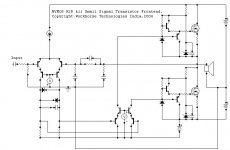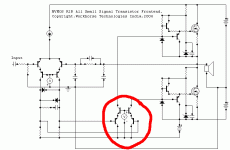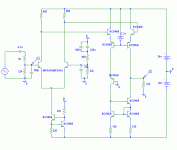Re: Widlarising and other stories
Thanks Andy, I lost that one.
Jan Didden
ALW said:
Thanks Andy, I lost that one.
Jan Didden
For the record, I only spoke to Bob Widlar once about audio. (I may have been interviewed by him for a job at Fairchild, in 1963, but I didn't get the job).
This was at an ISSCC conference, in PA, USA in 1974: Bob was on a panel of analog designers. I got up 'knee's quaking' (really) and asked that with the new knowledge of TIM put forth by Matti Otala, where do linear IC's stand with this? He said, that I SHOULD MAKE MY OWN AUDIO OP AMPS, because his designs and those of the others, as well, were NOT designed for audio.
Walt Jung was in the audience, and he came up to me afterward, we went to dinner that night, and have remained friends ever since.
This was at an ISSCC conference, in PA, USA in 1974: Bob was on a panel of analog designers. I got up 'knee's quaking' (really) and asked that with the new knowledge of TIM put forth by Matti Otala, where do linear IC's stand with this? He said, that I SHOULD MAKE MY OWN AUDIO OP AMPS, because his designs and those of the others, as well, were NOT designed for audio.
Walt Jung was in the audience, and he came up to me afterward, we went to dinner that night, and have remained friends ever since.
Steve Eddy said:
How 'bout if you look at the transistors as transconductance devices rather than current amplifiers as John once advised?
se

Why opamps don't fit audio? What parameters (and how the parameter should be) for audio stuff?He said, that I SHOULD MAKE MY OWN AUDIO OP AMPS, because his designs and those of the others, as well, were NOT designed for audio.
Hi All,
This CC-CB configuration is known as Rush Cascode and it terminates the differential action which is commonly seen in CE-CB stage....
We have used this type of configuration in our amps...It develops ultra high gain than other configurations....
regards,
K a n w a r
This CC-CB configuration is known as Rush Cascode and it terminates the differential action which is commonly seen in CE-CB stage....
We have used this type of configuration in our amps...It develops ultra high gain than other configurations....
regards,
K a n w a r
Attachments
Workhorse said:
.......Rush Cascode.......develops ultra high gain than other configurations....
Not really...
mikeks said:
Not really...
A one liner answer of doubtful usefullnes if there ever was one! Granted, I see no Rush 'cascodes' (complementary diff pairs) in Kanwar's schematic...
ilimzn said:... I see no Rush 'cascodes' (complementary diff pairs) in Kanwar's schematic...
What about the one in the red marking ?
BTW, they DO have immense gain...
Mike
Attachments
MikeB said:they DO have immense gain...
'immense gain'...compared to what?
Does depend on net collector load...
mikeks said:
'immense gain'...compared to what?
Does depend on net collector load...
Okay, you got me...

I made some sims and compared to double diffamp topology (keeping the cascodes)
The result: double diffamp 2 times the gain (1:56.000,-3db at 400khz) of the rush cascode at same bandwidth, but 20 times lower distortion...
Mike
Attachments
MikeB said:
What about the one in the red marking ?
Mike
Well, yes, but here it is really used as a cascode, no differential-ness about it
john curl said:Fellow engineers, what is wrong with this design? Please take me seriously.
Hello John,
I for one take you very seriously.
What, indeed, is wrong with this design?
john curl said:You first.Or let's let the rest of the class respond first.
Just home from a party and quite tired, but let me risk a guess at it.
There is nothing that sets a well defined Q current for the Rush cascodes in the VAS, so there is a potential risk for thermal runaway in them. If Tj increases, Ic will increase for a given Vbe,causing Tj to rise even more and... well you get it. Althogh the global NFB will maintain a near zero output voltage, I cannot see how it could prevent such themal problems in the VAS.
Of course proper cooling may be sufficient to make this a non-issue in practice.
Or a resistor between the emitters in the Rush cascodes could also prevent this problem, at the expense of lower gain.
john curl said:.......let the rest of the class respond first.
I wasn't aware you were conducting a 'class'...

It's the third time during this week we see Rush's name in this forum. Each time, some of us have pointed the fact that a circuit having a common base transistor does not imply that it is necessarily a cascode.
I even wonder if some circuits called "folded cascodes", where the biasing voltage of the input device is referenced to ground and the biasing voltage of the common base device is referenced to one of the power supply rails, can really be considered as a cascode.
There already were some previous threads about the Rush's circuit : it was said that the curious and interseting feature of the circuit is that it is a non-inverting (between the input base and the collector output ) amplifier circuit.
I even wonder if some circuits called "folded cascodes", where the biasing voltage of the input device is referenced to ground and the biasing voltage of the common base device is referenced to one of the power supply rails, can really be considered as a cascode.
There already were some previous threads about the Rush's circuit : it was said that the curious and interseting feature of the circuit is that it is a non-inverting (between the input base and the collector output ) amplifier circuit.
- Status
- This old topic is closed. If you want to reopen this topic, contact a moderator using the "Report Post" button.
- Home
- Amplifiers
- Solid State
- A different input stage


